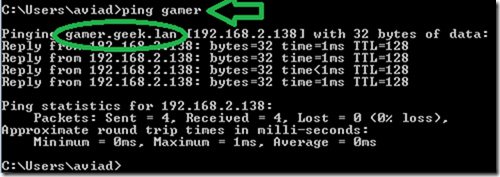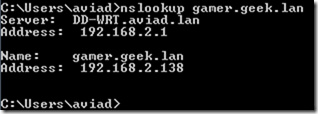Access computers using DNS and DD-WRT
TipsMake.com - In the following article, we will show you how to access remote computers using DNS on DD-WRT enabled router device. Not long ago, we introduced static DHCP features on routers with DD-WRT and how to make the client system always receive the same IP address from the router.
That is the case where we want access to any computer in the system when we know the specific IP address, but in fact, it is not always possible for the user to remember all of this IP address range. Besides, when the concept of UPnP appears, the inconvenience when using IP address is getting bigger. And this is also the reason why DNS appears.
The problem is when the user tries to connect from a computer or peripheral device on the network with an IP address (for example with a ping command), but this way only works in certain cases. So what is the problem? And how to solve it?
Technically, the device being used does not know how to switch from a common hostname value to an IP address, because the most important factor is missing, namely DNS suffix. When this process requires any computer to switch from a name value to an IP address, there are two ways to resolve it, the most basic way is to send a request through the Domain Naming System server (DNS) . However, in order to do this, the client system must resolve all information in the Fully Qualified Domain Name (FQDN) section.
A FQDN component contains the hostname value like mydesktop and the DNS part, such as geek.lan. Specifically, in our test, the FQDN part of the host will be mydesktop.geek.lan and mylaptop.geek.lan . When a machine in a client does not have a DNS element, it will of course not be possible to request DNS for a clearly specified name value. Therefore, when we want to access the host with the corresponding name, we must execute the previous ping command (eg ping mydesktop.geek.lan ). However, if the DNS suffix has been initialized somehow, the client system will automatically insert requests to the hostname and DNS server. If the DNS suffix has not been created, the clent will try to find the corresponding name by using the DNS broadcast.
Therefore, the only workaround is to set up, initialize the DNS value suffix on the router's DHCP. This process will cause the router to have additional dynamic DNS server services, and each computer in the client system can manually assign to that list, and allocate DNS suffix as well as parts of DHCP to the client. To do this, open the admin page, the main configuration of the router:

Select the Services section, change the Used Domain value to LAN & WLAN , in the LAN Domain section you enter the domain name (in this test is geek.lan ). While using static DHCP, specify the hostname section to match the name of the computer or device in the operating system, click Save and Apply Settings.
However, there is one exception to this case. If we use .local, the Windows operating system will resolve quite neatly, and Linux will assign this information according to mDNS standard - Multicast DNS and ignore it. whole DNS server signal. And to check the results of this process, open the Command Prompt and type ipconfig , we will see that the DNS suffix section is not displayed as shown below:

Type ipconfig / release and then ipconfig / renew , the results displayed will look like this:

Continue this process on each client computer, and use only the hostname. We will see that this client system does not automatically understand the full name of the device being pinged to:

However, if you encounter some pretty complicated and confusing problems, check out some things like:
- Clear DNS caching: because the DNS cache part may overflow the necessary cache, and will cause confusion in the DNS conversion process. With Windows it will be resolved by ipconfig / flushdns
- Ensure that the client system is using the router as well as the DNS that has been set up FQDN, especially when using VPN or other complex network systems. The simple way is to use nslookup to determine which DNS is being applied in the system:

Good luck!
You should read it
- Configuration, static DHCP settings on DD-WRT router
- Fix Access Denied in Windows 7
- Learn about the role concept in SQL Server
- Transfer Windows 2003 system with Exchange to Small Business Server 2008
- Instructions for creating virtual hosts with Apache in Ubuntu
- 4 ways to manage the process of Backup Windows Server 2008 on multiple servers
- Create VPN Server on Windows 8
- What to back up on a Linux Home Server system?
May be interested
- How to fix the error that cannot access another machine in Windows 10 LAN
 guide to check lan settings, turn off firewall, turn on network discovery and check the connection between two computers to get to the windows 10 lan.
guide to check lan settings, turn off firewall, turn on network discovery and check the connection between two computers to get to the windows 10 lan. - Instructions for installing LAN with the system using multiple operating systems
 we have had many articles instructing about lan. over time, a complex problem that many readers have encountered is when your lan system uses multiple operating systems such as windows 98, me, windows 2000, xp, windows 2000 server, windows 2003. that server is that many computers can't see each other or see each other. it's hard to access especially if windows 98 opens windows 2000, xp, and 2003 computers that are often asked for passwords even though you entered them. species
we have had many articles instructing about lan. over time, a complex problem that many readers have encountered is when your lan system uses multiple operating systems such as windows 98, me, windows 2000, xp, windows 2000 server, windows 2003. that server is that many computers can't see each other or see each other. it's hard to access especially if windows 98 opens windows 2000, xp, and 2003 computers that are often asked for passwords even though you entered them. species - Access and control remote Windows computers via Mac OS X system
 computers using windows xp professional, and some versions of windows vista or 7 (except home, basic and starter) can be remotely controlled via the remote desktop connection feature. this process allows others to log in and use windows-based computers as if sitting directly next to them ...
computers using windows xp professional, and some versions of windows vista or 7 (except home, basic and starter) can be remotely controlled via the remote desktop connection feature. this process allows others to log in and use windows-based computers as if sitting directly next to them ... - MS Access 2003 - Lesson 1: Chapter 1: Terminology Access
 this chapter is the first step in learning and familiarizing with basic terms, as well as how to start and exit access. you will get help and master the outline of what you can do with access.
this chapter is the first step in learning and familiarizing with basic terms, as well as how to start and exit access. you will get help and master the outline of what you can do with access. - Access computers everywhere with WinVNC
 accessing computers remotely is an essential requirement for many computer users. so use remote desktop of windows xp or download the realvnc virtual network computing (vnc) software for free to access the remote computer.
accessing computers remotely is an essential requirement for many computer users. so use remote desktop of windows xp or download the realvnc virtual network computing (vnc) software for free to access the remote computer. - The 'Connected With Limited Access' error in Windows
 when setting up or using a windows computer network, the connected with limited access error message may appear for several reasons.
when setting up or using a windows computer network, the connected with limited access error message may appear for several reasons. - Top 3 Apps to help you access, control computers remotely by phone best 2020
 top 3 apps to help you access and control your computer remotely with your phone by the best of 2020. the era of technological development helps us a lot in our daily work, can be used anywhere. voice control, can be used by computers
top 3 apps to help you access and control your computer remotely with your phone by the best of 2020. the era of technological development helps us a lot in our daily work, can be used anywhere. voice control, can be used by computers - 10 How to access blocked websites
 using computers of your company, office or school you can not access facebook or some websites because the computers are blocked. you are looking for ways to access facebook and blocked websites.
using computers of your company, office or school you can not access facebook or some websites because the computers are blocked. you are looking for ways to access facebook and blocked websites. - Unable to access 192.168.1.1: Cause and remedy
 why can't i go to 192.168.1.1? it is a question that many people are interested in. to fix bugs that cannot be accessed 192.168.1.1, follow the instructions below.
why can't i go to 192.168.1.1? it is a question that many people are interested in. to fix bugs that cannot be accessed 192.168.1.1, follow the instructions below. - How to fix network problems but can't access some websites
 in the process of using our computer to work, especially the use of the internet to access web sites, we will often encounter errors of failing to access random web sites. this is a common error on computers, they occur continuously on many different web sites.
in the process of using our computer to work, especially the use of the internet to access web sites, we will often encounter errors of failing to access random web sites. this is a common error on computers, they occur continuously on many different web sites.










 Wireless network design with NetSpot for OS X
Wireless network design with NetSpot for OS X 6 most vulnerable Wi-Fi security errors
6 most vulnerable Wi-Fi security errors Upgrade the router using Tomato firmware
Upgrade the router using Tomato firmware Configure One-to-One NAT with TMG 2010
Configure One-to-One NAT with TMG 2010 5 steps to troubleshoot Wi-Fi network problems
5 steps to troubleshoot Wi-Fi network problems Set up remote access with dynamic IP address
Set up remote access with dynamic IP address